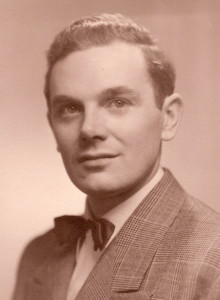True Tales: Bolsterisms
By George T. ComeauThe following is an excerpt from “Bolsterisms,” the latest installment of True Tales from Canton’s Past by local historian George T. Comeau.
There is a certain charm and nostalgia to folklore. Many of the stories that we choose to pass down to successive generations are built from the collective memories of the people who share and tell stories. This writer grew up surrounded by folklorists who spun wonderful stories rooted in Canton’s history.

Edward Bolster, the inveterate embellisher of stories, said that he used a $1 coupon to sit for this photo taken in 1943. (Courtesy of the Canton Historical Society)
One of the finest storytellers of all time was Edward Bolster. With a twinkle in his eye, Bolster had all the trappings of an actor. Schoolchildren would be mesmerized by his stories, and I count myself among those fortunate enough to have watched this man in action. Growing older, Bolster confided in me the trick he used frequently in his storytelling, “If you do not know the answer to the question, simply make it up,” he explained. To this day, I repeat his quote, attribute it to him — and tend not to follow his advice. Bolster’s stories were fantastic, epic, and usually wildly embellished.
Even today, I count fellow curator Jim Roache with having healthy doses of “Bolsterisms” when faced with an uncertain question of provenance of an ancient Canton story. In particular, there is a table purportedly from the Doty Tavern that survives in the local historical society with an accompanying story of heroic firemen saving the artifact only to wind up inebriated from the tavern’s liquor supply and the tavern burning to the ground. Roache explains he is merely keeping the tradition alive as he spins the tale through history.
Another grand spinner of yarns was Daniel Keleher, the former police chief. To this day his stories still resonate for me, largely because he saw Canton in his mind’s eye as utopia and larger than life. Keleher once swore to me that he had personally “shot stray dogs in the street — per the town of Canton bylaws.” It was a highly unlikely story meant to shock a local pet lover who covered her ears and shouted “nooooo, Dan, nooooo.” I can still remember the wink and nod as his tall story achieved the desired effect and shock value.
The stories that you read in this paper today are frequently well researched and involve a small cadre of historians who have in-depth knowledge of the facts at hand. Readers will tell me that they have learned so much from reading these stories, to which I always answer an enthusiastic “me too!” Yet many, if not all of my columns are rooted in the art of folklore and tidbits of stories that have bubbled up over the years. Once the tantalizing nugget of the story is revealed, then the work begins. There is always a back-story and an epilogue that rounds out and colors the chronicle leading to the True Tale that you read here.
Perhaps the largest treasure trove of stories that exists today are found in the correspondence between John Spare and Daniel Huntoon concerning Canton’s history as Spare recalled his youth in Ponkapoag. The letters were written between 1875 and 1884 and cover tall tales from 1816 through 1842. Spare was born in a house that is long gone, but stood at the “13th milestone,” which is now in the cloverleaf of Route 128.
From these letters we find tantalizing details about a circus traveling through Ponkapoag in 1825 with an elephant placed on display in a farmer’s barn. There is the story of the local militia marching up Great Blue Hill on July 4, 1826, to celebrate the semi-centennial. At the top of the hill more than 20 barrels of tar were perched high atop poles spaced about 15 feet apart and set fire so that all the towns could see the display.
Some of the stories in the letters need modern research to bear them out. Take for instance the wonderful gem that tells of an abandoned road off present-day Elm Street in which Spare observes, “In examining the abandoned road, please do not fail to notice the cannon ball, as known to all boys who drove cows fifty years ago (1825), as I did, by it; about half a mile west of the Stone Bridge going west, the wall, in the center of which is the ball…” The letter goes on to describe that “the Cannon Ball is otherwise on a path leading from Captain William Shaller’s in his rear to a residence of a McIntosh, via the Old Dam.”
So many clues for historians to track down before an intrepid hunt in the woods (on private property) to find that old stone with the cannon ball embedded deeply for almost 200 years. Who is up for an adventure …
See this week’s Canton Citizen for more local tall tales — including one man’s encounter with a dancing bear. Not a subscriber? Click here to order your subscription today.
Short URL: https://www.thecantoncitizen.com/?p=29087










